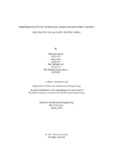Performance study of bifacial module based time varying Multilevel Solar Panel System (MSPS)
Abstract
Sun based energy exists in two structures that we can use for electrical change. One is
immediate sunlight based on thermal, making a superheated liquid which can be utilized to
make steam and turn a turbine. There are sure spots on the Earth that can utilize this innovation
and asset, however, they need a ton of direct cloud-free daylight for a long time for every day
consistently. The alternate way sun-oriented energy can be utilized is the immediate change of
sunlight-based energy to power utilizing photovoltaic. Solar energy is the only major power
generation process that does not require a turbine. The sun is the biggest combination reactor
in our close planetary system. Sun-powered energy has the guarantee and potential to tackle
the energy emergency of Bangladesh, the restricted space for setting enough sun oriented
photovoltaic (PV) panels to fulfill the need of city inhabitants arises as a requirement in
actualizing sun-based energy framework in thickly populated metropolitan regions. The target
of this research is to do a performance study of bifacial module based multilevel solar panelbased system concerning solar time. As the bifacial module outfits energy from both sides of
the module, this necessitates unique thought to figure the irradiation on both surfaces of the
solar panel module. Overall, the study based on the simulation and calculate the irradiance, the
modified version of an isotropic diffused model derived by Liu and Jordan has been applied.
In succession, different parameters (view factor, albedo) were needed to be introduced in this
model. This research presents a developed model of multilevel solar panel system compatible
for urban areas which is capable of increasing 29.40% more yearly electrical output than a
typical multilevel mono-facial system.

